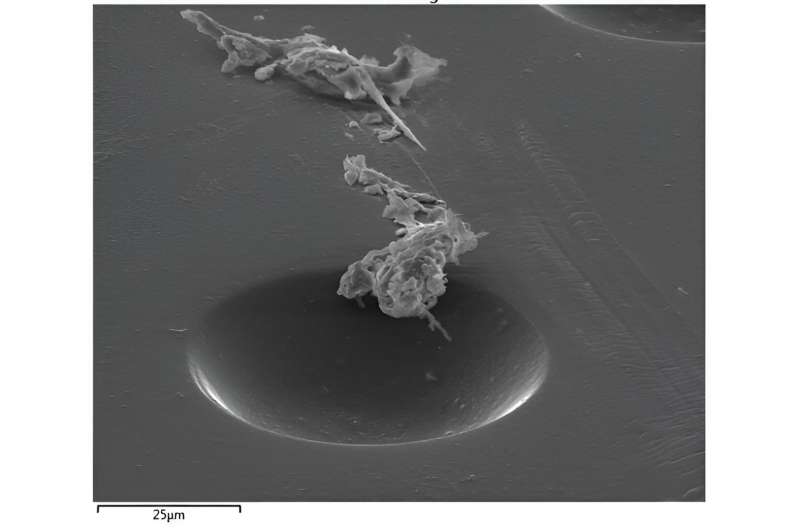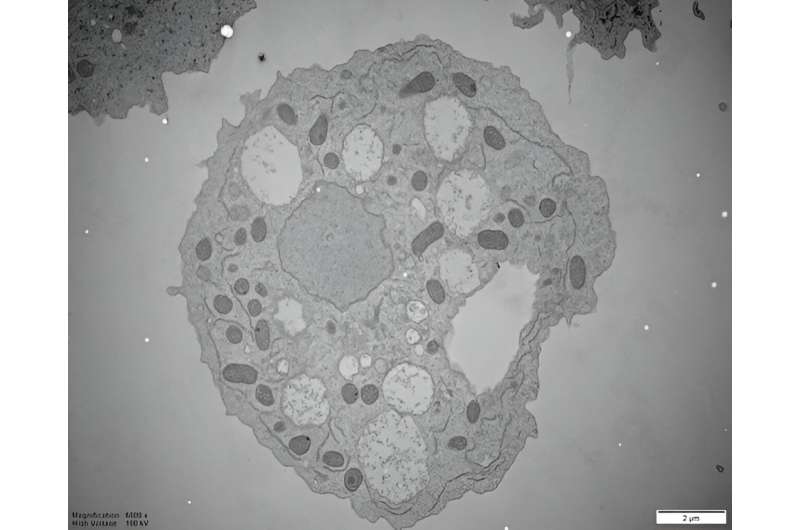This article has been reviewed according to Science X's editorial process and policies. Editors have highlighted the following attributes while ensuring the content's credibility:
fact-checked
peer-reviewed publication
trusted source
proofread
Microorganism that causes rare but severe eye infections detected in Australian coastal areas

Researchers have identified the microorganism Acanthamoeba, which can cause an extremely rare but potentially sight-threatening eye infection, in seawater at four New South Wales coastal sites. The new research is published in Science of The Total Environment, and is a collaboration between University of New South Wales Sydney, University of Technology Sydney (UTS) and the University of the West of Scotland.
Acanthamoeba keratitis (AK) occurs when Acanthamoeba infects the cornea, the clear outer layer at the front of the eye. Acanthamoeba feeds on bacteria and corneal cells, leading to inflammation and damage to the cornea. Infection is difficult to eradicate due to the absence of drugs that can kill Acanthamoeba in both its cyst and trophozoite life stages. This can lead to vision loss, with around one quarter of AK patients ending up with less than 25% of vision or becoming blind.
AK is very rare, estimated to affect 10–40 Australians per year. But it is important to be aware, particularly for those who wear contact lenses. Acanthamoeba from the environment can get trapped between the contact lens and the eye, leading to infection.
"Wearing contact lenses is the leading risk factor, particularly if people mix their contact lenses with contaminated water," says first author Binod Rayamajhee, who is completing a Ph.D. focused on Acanthamoeba at UNSW Medicine & Health.
UNSW researchers previously found that around one third of the tap water in bathroom sinks in greater Sydney contains Acanthamoeba. Washing contact lenses in tap water is a major risk factor for AK, as well as showering and swimming with contact lenses in.
"There have been two previous studies, one in Sydney and another in Melbourne, suggesting that nearly 20% of patients acquired AK after swimming in seawater or fresh water with their contact lenses," Mr. Rayamajhee says.
However, levels of Acanthamoeba in Australian aquatic environments have not been studied until now.
Testing NSW coastal waters
During the study, the researchers collected water samples from four NSW coastal sites. These locations are used for recreational activities like swimming or kayaking, and water quality is monitored regularly for safety purposes. Proximity of these sites to urbanized areas can lead to some water contamination, which potentially facilitates the growth of Acanthamoeba.
"We chose coastal sites to look for the presence of Acanthamoeba species that we knew experienced high levels of seasonal variability in environmental conditions, as well as intermittent impacts from stormwater and sewage contamination. We aimed to identify any links between environmental factors and the presence of the organism," says co-author Professor Justin Seymour, who leads the Ocean Microbiology Group at UTS.
The researchers collected multiple samples from each site each month from August 2019 to July 2020 (except March and April 2020 due to COVID-19 restrictions). They measured water characteristics including temperature, dissolved oxygen concentration, pH, and salinity. In addition, the researchers extracted DNA from the water, which allowed them to measure the levels of Acanthamoeba and bacterial communities.
Detection of Acanthamoeba
Acanthamoeba was present in water samples from all four coastal sites, with 38 percent of the water samples overall testing positive.

The prevalence of Acanthamoeba varied across the sites. For the most highly urbanized site, more than 50% of the samples tested positive. In contrast, for the least urbanized site, 32% of the samples contained Acanthamoeba.
The study found a positive correlation between the presence of Acanthamoeba and elevated levels of the intl1 gene in the water samples. The intl1 gene serves as an indicator of contamination in aquatic habitats due to human activity.
Taken together, these results suggest that urbanized coastal sites could be impacted by contaminants like sewage, animal feces and storm water, potentially creating a better environment for Acanthamoeba.
"The contaminated water allows the Acanthamoeba to flourish, as it feeds on the nutrients and a wide range of bacteria," Mr. Rayamajhee says.
The researchers also found that Acanthamoeba was more prevalent in the water during the summer months. In January, 65% of the samples tested positive (the highest rate), compared to 5% in September (the lowest rate). They also found a weak positive correlation between water temperature and presence of Acanthamoeba.
"When we look at global data, there are more AK cases during summer, when recreational activities are likely to be at their highest," Mr. Rayamajhee says.
"With rising temperatures and increased stormwater runoff due to climate change promoting algal blooms in seawater, urbanized coastal waterways could potentially become favorable habitats for Acanthamoeba. However, further investigation is crucial to accurately determine the prevalence of Acanthamoeba in the region."
Avoiding AK infection
According to the researchers, these findings highlight the widespread prevalence of Acanthamoeba in the environment, and the importance of public awareness. While AK infections are extremely rare in Australia and worldwide, they can lead to serious vision loss.
"Many public health messages about swimming safety focus on microbes that cause gastrointestinal infections. This paper highlights the risk of eye infections while swimming in contact lenses and calls for reminder signs at pools and recreational water facilities to remove contact lenses before swimming," says senior author Associate Professor Nicole Carnt from UNSW Medicine & Health.
Contact lens wearers should not panic or avoid swimming altogether, but they should be careful to avoid developing AK. They should also monitor for early symptoms such as eye pain and redness, blurred vision, light sensitivity and excessive tearing.
"For people planning to do water activities in these areas, it's strictly advisable to take off your contact lenses before getting in the water," Mr. Rayamajhee says.
"No one should be panicking… But the best thing people should be doing is taking their contact lenses off and never mixing them with water regardless of the water source."
More information: Binod Rayamajhee et al, Identification and quantification of Acanthamoeba spp. within seawater at four coastal lagoons on the east coast of Australia, Science of The Total Environment (2023). DOI: 10.1016/j.scitotenv.2023.165862



















